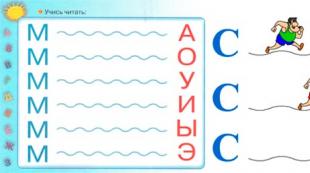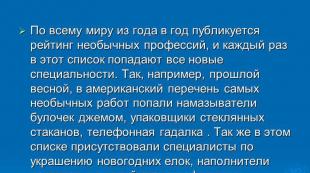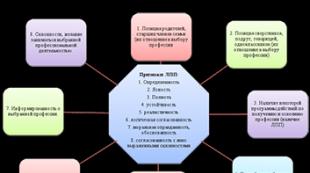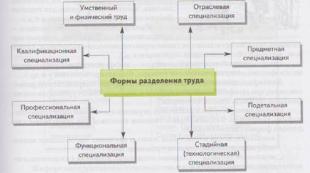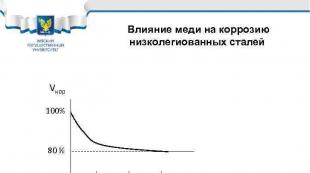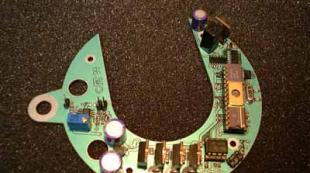Syllables and letters for learning to read. Texts for reading by syllables. Reading simple words syllable by syllable
Learning to read syllables - this stage in teaching children to read is one of the most important and difficult. Often parents simply don’t know how to teach their child to pronounce two letters together and get “stuck” on this for a long time. Tired of the endless repetition of “ME and A will be MA,” the child quickly loses interest, and learning to read turns into torture for the whole family. As a result, children who already know letters from the age of two or three cannot read simple words even by the age of five, not to mention reading sentences and books.
What to do next when the child has memorized the letters? Let’s immediately make a reservation that teaching a preschooler to read syllables can begin BEFORE he has mastered the entire alphabet (moreover, some teachers insist that you need to move on to syllables as quickly as possible, without waiting for all the letters to be learned). But the child must name the letters that we will combine into syllables without hesitation.
In order to begin learning to read syllables, a child only needs to know 3-4 vowels and several consonants. First of all, take those consonants that can be drawn out (S, Z, L, M, N, V, F), this will help teach the child how to pronounce the syllable together. And this is a fundamentally important point.
So, let's look at several, in our opinion, the most effective methods that modern teachers offer for teaching a child to form letters into syllables.
1. Play "Trains"
(game from the manual by E. Baranova, O. Razumovskaya “How to teach your child to read”).
Instead of boring cramming, invite your child to “ride the train.” All the consonants are written on the rails on which our trailers will travel, and the vowels are written on the trailers themselves. We place the trailer on the rails so that a consonant appears in the window, and name what station we have (for example, BA). Next, we move the trailer down the rails until the next consonant and read the syllable that appears.
There is a similar manual in cards "Game "Steam Locomotive". We read the syllables." from E. Sataeva
This game is good because the child does not need to be specifically explained how to add syllables. It is enough to say: “Now we will ride the letter A, it will be our passenger, name all the stations where we will stop.” First, “take a ride” yourself - let the child move the trailer along the rails, and you loudly and clearly call the “stations”: BA, VA, GA, DA, ZHA, ZA, etc. Then invite your child to do this with you in turn. During the game, listening to you, children easily grasp how to pronounce two sounds together. The third time, the child can “ride” himself without much difficulty.
If the child does not know all the letters, stop only at those “stations” that are familiar to him. Next we change the trailer. Now we roll the letters O, U, Y. If the child copes with the task easily, we complicate the task. For example, we go for a speed ride, timing which of the trailers will get to the end of the journey first. Or another option: when stopping at a station, the child must name not only the syllable, but also the words starting with this syllable (BO - barrel, side, Borya; VO - wolf, air, eight; GO - city, golf, guests; DO - rain, daughter, boards, etc.).
Please note that with this game you can practice reading not only open syllables (with a vowel at the end), but also closed ones (with a consonant at the end).
To do this, we take the trailers where the vowels are written in front of the window, and proceed in the same way. Now we have a letter on the trailer, not the passenger, but the driver, she is the main one, she is in front. First, read the resulting “stations” with closed syllables yourself: AB, AB, AG, AD, AZ, AZ, etc., then offer the child a “ride.”
Remember that in this and other exercises we first practice adding syllables with vowels of the first row (A, O, E, U, Y), and then introduce vowels of the second row (Ya, Yo, E, Yu, I) - so-called “iotated” vowels, which make the sound preceding them soft.
When the child is good at reading individual tracks with syllables, alternate the carriages with passengers and drivers, without prompting which particular carriage we will be rolling. This will help the child learn to clearly see where exactly the vowel is in a syllable (the syllable begins or ends with it). At the first stages of learning to read syllables, a child may have difficulties with this.
2. “Run” from one letter to another
(from “ABC for Kids” by O. Zhukova)This is a visual exercise that will help your child learn to pronounce two letters together.

Before us is a path from one letter to another. To overcome it, you need to pull the first letter until the finger we move along the path reaches the second letter. The main thing we are working on in this exercise is so that there is no pause between the first and second sound. To make it more interesting to practice, replace your finger with a figurine of any animal/person - let it run along the path and connect two letters.
(“A Primer for Kids” by E. Bakhtina, “Russian ABC” by O. Zhukova, etc.).
 Many authors of primers and alphabet books use animated images of letters that need to be put into a syllable - they are friends, walk together in pairs, pull each other through obstacles. The main thing in such tasks, as in the previous exercise, is to name two letters together so that the two companion letters remain together.
Many authors of primers and alphabet books use animated images of letters that need to be put into a syllable - they are friends, walk together in pairs, pull each other through obstacles. The main thing in such tasks, as in the previous exercise, is to name two letters together so that the two companion letters remain together.

To use this technique, you don’t even need special manuals or primers. Print out several figures of boys and girls (animals, fairy-tale or fictional characters), write a letter on each of them. Let consonants be written on the boys' figures, and vowels on the girls' figures. Make friends with the children. Check with your child that boys and girls or two girls can be friends, but making two boys friends (saying two consonants together) is not possible. Change pairs, put girls first in them, and then boys.

Read the syllables first in one order, then in the reverse order.
These few techniques are quite enough to teach a child to add two letters into a syllable. And learning in the form of a game will allow you to avoid cramming and boring repetition of the same thing.
4. Games to strengthen the skill of adding letters
— Syllabic lotto
It’s very easy to make them yourself; to do this, you need to select several pictures - 6 for each card and print out the corresponding syllables.

- The guide will help you “Syllables. Choose a picture based on the first syllable BA-, BA-, MA-, SA-, TA-. Educational lotto games. Federal State Educational Standard of Education "E. V. Vasilyeva"— there are several more tutorials in this series “Letters, syllables and words. Lotto with verification" by A. Anikushena
- Similar exercises are in the book. “Syllable tables. Federal State Educational Standard" N. Neshchaeva
— Shop game
Place toy products or pictures with their images on the counter (for example, FISH-ba, DY-nya, PI-horns, BU-lka, YAB-loki, MYA-so). Prepare “money” - pieces of paper with the name of the first syllables of these words. A child can buy goods only with those “bills” on which the correct syllable is written.
Make an album with your own hands with your child, in which a syllable will be written on one page of the spread, and on the other - objects whose names begin with this syllable. Periodically review and add to these albums. For more effective learning to read, close either one or the other half of the spread (so that the child does not have unnecessary clues when naming a syllable or selecting words for a certain syllable).

They will help you with this “Cards for sound and syllabic analysis of words.”
— Airfield game (garages)
We write the syllables large on sheets of paper and lay them out around the room. These will be different airfields (garages) in our game. The child takes a toy plane (car), and the adult commands which airfield (in which garage) the plane should be landed (the car parked).
Zaitsev's cubes or any cards with syllables (you can make them in the form of traces) are suitable for this exercise. We build a long path from them - from one end of the room to the other. We choose two figures/toys. You play one, the child plays the other. Roll the dice - take turns with your figures on the cards for as many moves as the number rolled on the dice. As you step on each card, say the syllable written on it.
For this game you can also use various “adventures” by writing syllables in circles on the playing field.

5. Reading simple words syllable by syllable
Simultaneously with practicing syllables, we begin to read simple words (of three or four letters). For clarity, so that the child understands what parts a word consists of, which letters need to be read together and which ones separately, we recommend that the first words be made up of cards with syllables / individual letters or graphically divide the word into parts.

Words of two syllables can be written on pictures consisting of two parts. Pictures are easier to understand (the child is more willing to read words written on them than just columns of words) plus it is clearly visible into what parts a word can be broken down when reading it syllable by syllable.

Increase the complexity gradually: start with words consisting of one syllable (UM, OH, EAT, UZH, HEDGEHOG) or two identical syllables: MOTHER, UNCLE, DAD, NANNY. Then proceed to reading three-letter words (closed syllable + consonant): BAL, SON, LAK, BOK, HOUSE.
You need to understand that even if a child pronounces all the syllables in a word correctly, this does not mean that he will immediately be able to meaningfully put them together into a word. Be patient. If a child has difficulty reading words of 3-4 letters, do not move on to reading longer words, much less sentences.
Be prepared for the fact that your child will begin to read words fluently only after he has automated the skill of adding letters into syllables. Until this happens, periodically return to practicing syllables.
And, most importantly, remember that any learning should be a joy – for both parents and children!
Philologist, teacher of Russian language and literature, preschool teacher
Svetlana Zyryanova
If a child is taught to put letters into syllables, it means they are teaching him sound method. And this is a logical and understandable chain of learning to read: sounds (along with their visual letter image) → syllables → words → sentences.
Historical preface
The sound method was proposed by the great teacher D.K. Ushinsky more than 150 years ago instead of the subjunctive and was supported by D. Tikhomirov, F. Zelinsky, L. Tolstoy and others. Previously, children first memorized the names of letters: az, beeches, lead, and so on. Then the syllables were memorized: “buki” and “az” in this sequence form “ba”, “az” and “vedi” - “av”... Then words were formed, and the teacher had to explain each unfamiliar syllable, and the student had to memorize it. Those. the child did not understand how the letters are connected into warehouses.
When learning to read using the sound (or sound-letter, phonetic, speech therapy) method, the process was greatly simplified: from the very beginning, children learned meaningfully, understanding the technique of adding sounds. This is how our parents, grandmothers, and great-grandmothers learned to read and write, and as experience shows, in 100% of cases it was successful.
Putting sounds into syllables
To explain to your child how to combine two letters into a syllable, you can use several techniques and games.
The method proposed and described in the “Primer” by N.S. Zhukova
Having written (or laid out cards or magnets) two letters at some distance from each other, connect them with a pointer or pencil. At the same time, you need to pronounce the first sound until it “reaches” the second. The child needs to explain: “Pull the first letter until you reach the second letter along the path.” You can draw a boy running between the sounds and tell the baby: “Pull the 1st letter until you and the boy along the path reach the second.” At the same time, the baby runs his finger (pencil), connecting the letters. 
Using the same principle, you can draw how one letter catches another with a fishing rod, or depict them as parts of a train. In short, the main thing is that it is understandable and interesting for the child.
So, first, children are taught to connect vowel letters (“ua”, “au”, etc.), then reverse syllables (“am”, “us”...) and thirdly direct ones. If your baby can’t put together two certain sounds, you can try working with others. Let's say, instead of "M" take "S".
Changing letters
You will need cards. The adult shows one letter and the child reads it. At the same time, the second letter is brought from afar, the first is removed, and the child immediately proceeds to voicing the new letter. This needs to be done so that the baby names the entire syllable without a break:
M M M M A A A A,
S S S S O O O O.
Singing syllables (Logorhythmics)
Repeatedly singing syllables is a small, but often very effective technique. Many children perceive and understand more easily the combination of letters into syllables if they are shown and sung:
MA – MO – MU, BA – BO – BU, etc.
Sa-sa-sa...
Zhu-zhu-zhu...
You can easily find similar videos on YouTube (search for the word “logorhythmics”). But it’s better to take the lyrics from the video and basically sing it yourself, rather than just turn on your computer or tablet.
You can sing warehouses by folding them in any of the ways. However, you shouldn’t put words together in the same way later - the child can sing sentences in syllables even without pauses.
Friendship of sounds
This is a fun educational game that can be suitable for children from 3.5 to 6 years old, depending on individual characteristics. You need to take the ball and explain to the child that sounds really want to be friends, and you need to help them with this. The adult says: “M” wants to make friends with “A,” and throws the ball to the baby. He catches it and throws it back, saying: “MA.” Next: “O” wants to be friends with “M” - the ball flies to the baby, who returns it accompanied by: “OM”.
You can play without a ball, asking the child to make friends, for example, “B” and “A”. It is useful to develop the exercise by offering to help different sounds get along with one: “Let's help the letters make friends with “U.” The adult calls: “M.” The child answers: “MU.” “S” – “SU” and so on.
This way the baby will learn to connect letters by ear.
Conclusion

No matter how you teach a child to connect letters into syllables, you need to understand that this can be hard work for a child. And in order to make it as easy and simple as possible, it is better to do everything in a playful way, come up with your own tricks, repeat the same sounds and the way they are put together many times. But when the child firmly masters combining letters into syllables, he will read in the future without errors.
Children's texts for reading by syllables. Read on your own. When a child learns to read, some children need to read syllable by syllable, while some find it more convenient to read in full words without divisions by dashes. The page provides simple texts in both versions. We read syllable by syllable.
There was a thunderstorm. It was raining heavily. Thunder rumbled. Try-to-get-under-the-mushroom. Mi-mo do-ro-ge is half-evil at-lit-ka. Stre-ko-za-vo-rit:
-U-lit-ka, uh-lit-ka! Come to me. It's dry here, like under. roof.
- I don’t need a roof! My house is with me.
Storm
There was a thunderstorm. It was raining heavily. Thunder rumbled. The dragonfly climbed under the mushroom. A snail crawled past along the road. Dragonfly says:
-Snail, snail! Come to me. It's dry as hell here. roof.
- I don't need a roof! My house is with me.
It's not just a thing
Mi-sha broke the ma-le-n-ky do-bok.
- Why did you do this? - oh-gor-chi-la-s Ma-sha.
- Yes, it’s just the same!
“No, you gu-beat a lot, mo-gu-che-e de-re-vo,” said Ma-sha.
It's not just a twig
Misha broke a small oak tree.
- Why did you do this? – Masha was upset.
-It’s just a twig!
“No, you destroyed a big, mighty tree,” said Masha.
Ze-blah-no-ka
Re-bya-ta gu-la-li in the forest. Out-la Na-dya on po-la-nu. He looks: oh, how red I am. I haven't been here for a year. I collected them in la-dosh-ku, but didn’t eat them.
-Peter! Vasya! Come to me! Earth-la-no-ka! First-of-the-earth!
Come on. And everyone is two years old
-Oh, how delicious it is!
Soon there will be a lot of earth. But the first years are the best.
Strawberries
The guys were walking in the forest. Nadya came out into the clearing. She looks: there are red berries near her. There were few berries. Nadya collected them in her palm, but did not eat them.
-Peter! Vasya! Come to me! Strawberries! First strawberry!
The guys came running. And everyone has two berries.
-Oh, how delicious!
Soon there will be a lot of strawberries. But the first berries are the tastiest.
Morning
The boy and the girl are going to school.
And Lena is drinking tea.
“Daughter, it’s already seven o’clock!” says mA-ma.
Lena looks at her watch.
-The clock is blowing too much, ma-moch!
- No, Le-noch-ka. The clock is ticking right. And you eat everything slowly.
Morning
A boy and a girl go to school.
And Lena is drinking tea.
“Daughter, it’s already eight o’clock!” says mom.
Lena looks at her watch.
-Our clock is going too fast, mommy!
- No, Lenochka. The clock is running correctly. And you do everything slowly.
In Soviet times, teaching reading was the concern of teachers. Today, first-graders who cross the threshold of school can read, write in block letters and begin to comprehend foreign languages. And although such an impressive wealth of skills and abilities is not a mandatory requirement for a future student, many parents from an early age are engaged in the education of their offspring so that he does not lag behind his peers and easily and quickly masters the complex school curriculum. How to teach a child to read syllables without pedagogical education and special knowledge? Let's turn into teachers!
Determining the level of training
In order to correctly set educational goals, you must first determine the child’s level of preparation and eliminate the “gaps” in a timely manner. Don't start learning to read if:
- the preschooler’s speech has not yet formed, he cannot correctly compose a sentence, and is not able to reproduce a short story;
- there are problems of a speech therapy nature (the baby must not only pronounce sounds correctly, but also maintain rhythm and melody in his speech);
- the child confuses spatial concepts (right/left, up/down);
- phonemic hearing is poorly developed (the ability to identify sounds in a word, their position);
- concentrates on one object for less than 10 minutes.
First, we eliminate the existing problems and only then teach them to read. Otherwise, the process will drag on, the child will quickly get bored and will not bring good results.
“Refresh” the material in our head
Parents may have forgotten the sequence of letters in the alphabet and what they are correctly called. Therefore, we open the textbook and remember.
First figure out for yourself how a letter differs from a sound. For those who don’t remember: we see letters, we pronounce sounds. There are 33 letters, the sounds they represent are consonants and vowels. The former are also divided into hard and soft, voiced and voiceless. This is enough for now, repeat the rest when the child becomes a first grader!
Tune in psychologically to the process:
- do not expect quick results; for them to appear, systematic and consistent exercise will be required;
- be prepared to explain the same thing multiple times;
- You are constantly looking for new ways and means of learning.
Let's understand the methods

Today, a huge number of methods are available, suggesting different approaches to learning.
For example:
- They teach syllabic reading - the child memorizes letter combinations and then composes words from them.
- - suggests memorizing the spelling of whole words.
- Rough ones help to learn the alphabet through sensory abilities.
It is difficult to call any method flawless, because they also have drawbacks. Therefore, it is better to turn to the good old sound-letter method, and Montessori, Doman, Zaitsev and other innovators will help diversify classes.
Where to begin
Now let’s decide on the manual we will use for training. “Primer” by N.S. has proven itself well. Zhukova, in which classical methods overlap with speech therapy content and unique author’s developments.

N.S. Zhukov, to the question: “How to quickly teach a growing child to read?” answers - together, and it is not necessary to know all the letters. A few vowels and consonants are enough, from which you can make letter combinations.
First we study open vowels: “A”, “U”, “O”, “Y”, “E”. Then sonorant consonants - “ M", "N". At this stage, using Zhukova’s ABC book, we begin to explain how syllables are made from letters. The colorful illustrations show how one letter rushes towards another, merging with it into a syllable. For example, " M"hurries to "O", we pronounce it together "M-m-m-o-o".
The main thing for a child is to understand the mechanism of their merging; with new letters he will be able to do everything mechanically. All learned syllables must be repeated often and regularly so that their reading becomes automatic.
Read not only simple open letter combinations in which a vowel follows a consonant (“MA”), but also complex “vowel-consonant” (“AM”), fusions of three sounds (“ARO”, “PRA”).
Let's take p. 18 from the primer as an example.

Name the first letter - the parent asks.
“X,” the kid answers.
- Which letter does “X” go to?
- To the letter "A".
- It turns out: “X-x-x-A”. While the letter “X” is running towards “A”, stops cannot be made - they sound together.
Having learned just a few of these examples, a preschooler will understand the principle of constructing syllables and will be able to apply it to other sounds.
Never pronounce sounds in a syllable separately from each other! For example, “N” and “O” - “BUT”. This method can delay the learning process for a long time. Teach your child to chant: “N-n-n-o.”
What else will help you add syllables?
A great way to learn how to pronounce syllables together is to sing the sounds. This is often taught by kindergarten teachers. Chanting helps many children. Some, getting carried away, can sing a whole sentence or even a paragraph together.
Thematic material:
You need to constantly remind your preschooler about pauses between words and sentences. I sang a word, stopped, sang the next word, pause again. Don’t worry, the pauses will gradually become shorter until the reading becomes meaningful and expressive.
Children learn most easily through play. The alphabet in pictures will help you remember a new letter (the letter being studied is accompanied by images of objects in which it appears), three-dimensional letters (made of clay, wood, etc.), rough Montessori letters, cubes. We studied the letter, made a manual for it and added the syllables.

If the child is about 3-4 years old, and the learning process has been delayed (more than 6 months), do not rush, postpone classes until 5 years. At this age, an interest in reading will appear on its own, and the baby will master science in 1-2 months.
When reading books to your baby, constantly focus his attention on how well he can read.
First, it is advisable to introduce syllables with two vowels (“AU”), then with a voiced consonant with a vowel ( "BA", "RO", "WE"), in the end there are hissing and deaf ones ( "TA", "HE", "SHI") and vowel-consonant pairs ( "AM", "ER", "UN").
Having mastered the syllables, move on to reading the simplest words: MA-MA, WE-LO, RA-MA. Always start your classes by reviewing and consolidating the material you have covered. Make sure that the future student does not forget to pause between words, check that he has mastered what he has read.
Let's take an example from the above-mentioned primer (p. 58). 
The photo shows the text “In the meadow.” We pronounce the syllables in a chant: “Here (pause) lu-zhok (pause). Here (pause) wanders around (pause) so-ba-ka (pause) Friend.” etc. After reading, we ask the child: “What is the text about? Where does the dog roam? What is her name?". If it is difficult for a child to answer immediately, we allow him to find the answer in the text.
The duration of the first lessons for preschoolers 4-5 years old is less than 15 minutes, then they are increased to half an hour.
Children 5-7 years old get tired quickly, so constantly change the type of activity: read - draw or print letters. It is advisable to use coloring books with images, so the preschooler will have a rest and practice his motor skills.
Interactive technologies
It is worth using online games and applications as an auxiliary (not the main!) means. Most of these programs are free for users and available on Android devices. For example, the Azbuka Pro program.
Some sites offer online exercises. For example, “The Cheerful Engine” or “Berylyaka Learns to Read.” If online learning is not convenient for you, you can download special CDs with ready-made lessons or educational videos for free.

Of course, such activities are very popular with modern children who adore high-tech devices. But do not forget that a child’s excessive interest in even useful online games and videos can affect their vision and emotional and mental health.
Therefore, it is better to use such learning tools to consolidate knowledge or while resting between sprinkling over a book.
10 useful games


Never force your child to learn letters. And to prevent home lessons from turning into boring and monotonous activities, diversify them with games.
With the right approach, teaching a child to read syllables is quite simple. It is much more important to instill an interest in reading, to make it thoughtful and regular. After all, as any teacher will confirm, a person’s literacy and the beauty of his speech depend on the amount of reading.
From syllabic reading to fluent reading
Read the sentence and ask your child to repeat it. Then increase the number of offers to 3 or more.
Remember! During the exercise, correct intonation, remind about logical pauses.
You can also select text with pictures instead of some words. The next stage is to exclude pictures from the text and insert the missing words, focusing on the meaning of the sentence.
